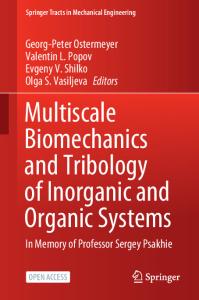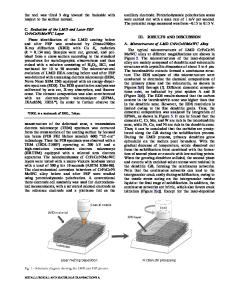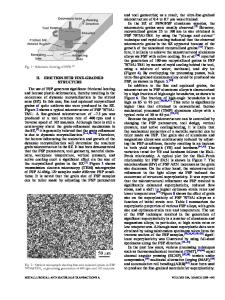Nanostructured Fe-20Cr-10Ni-2Si Layer Produced by Laser Cladding and Friction Stir Processing
- PDF / 3,110,960 Bytes
- 9 Pages / 593.972 x 792 pts Page_size
- 87 Downloads / 264 Views
INTRODUCTION
LASER cladding technology, as a wide-eyed advanced manufacturing technique, has attracted much attention and has been commonly applied in a number of fields, such as aerospace, track traffic, vessel and engineering plant lately.[1–3] Nevertheless, when laser cladding technology is applied in surface alloys with high hardness and wear resistance, it usually meets with severe challenges, such as metallurgical defects, solidification cracks, and fragile precipitating phase with a netlike distribution, which severely restricts its application in high-tech field.[4] With regards to the metallurgical defects controlling in the laser cladding process, although laser parameters adjustment can inhibit the metallurgical defects to a certain extent,[5,6] such as pores and microcracks, netlike interdendritic phases such as carbide or silicide are unavoidable, which was brittle and detrimental for the cladded part. So it is necessary to find an effective way to modify the metallurgical defects of the material processed with laser and the optimization of laser processed material like grain refinement has attracted much attention.[7,8] In
H.P. PENG is with the Jiangsu Key Laboratory of Oil and Gas Storage and Transportation Technology, Changzhou University, Jiangsu 213164, P.R. China. P.D. NIU, R.D. LI, L. HUANG, and T.C. YUAN are with the State Key Laboratory of Powder Metallurgy, Science and Technology on High Strength Structural Materials Laboratory, Central South University, Changsha 410083, P.R. China. Contact e-mails: [email protected]; [email protected] Manuscript submitted July 5, 2018. Article published online February 19, 2019. METALLURGICAL AND MATERIALS TRANSACTIONS B
general, the crack formation can be controlled by adding toughening elements or gradient heating during laser cladding,[9–11] however, cracks can’t be completely eliminated with these methods. It is common knowledge that most of the solidification defects can be solved by grain refinement; moreover, ultrafine grains or nanoscale grains help improve the mechanical properties, as what indicated by the Hall–Petch formulation. Severe plastic deformation (SPD) on the surface not only can enable the grain refinement, but also make the brittle phase crush and pore close, which is a feasible way for modification of metallurgical defects. The coarse grains are disintegrated and broken into ultrafine grains with different surface SPD methods like surface mechanical grinding,[12] air blast shot peening,[13] and surface sliding friction.[14] Compared with other SPD process, friction stir processing (FSP) produced material has high microstructural homogeneity and fast processing efficiency. Based on this, FSP assisted laser cladding technology is applied for preparing alloy layer with fine grain and homogeneous precipitation phase with its strong thermal and mechanical coupling effect in this essay. The deformation zone of the ultrafine-grain shows excellent mechanical properties. The invention of FSP is based on the ground rule of friction stir welding (FSW), which was
Data Loading...











